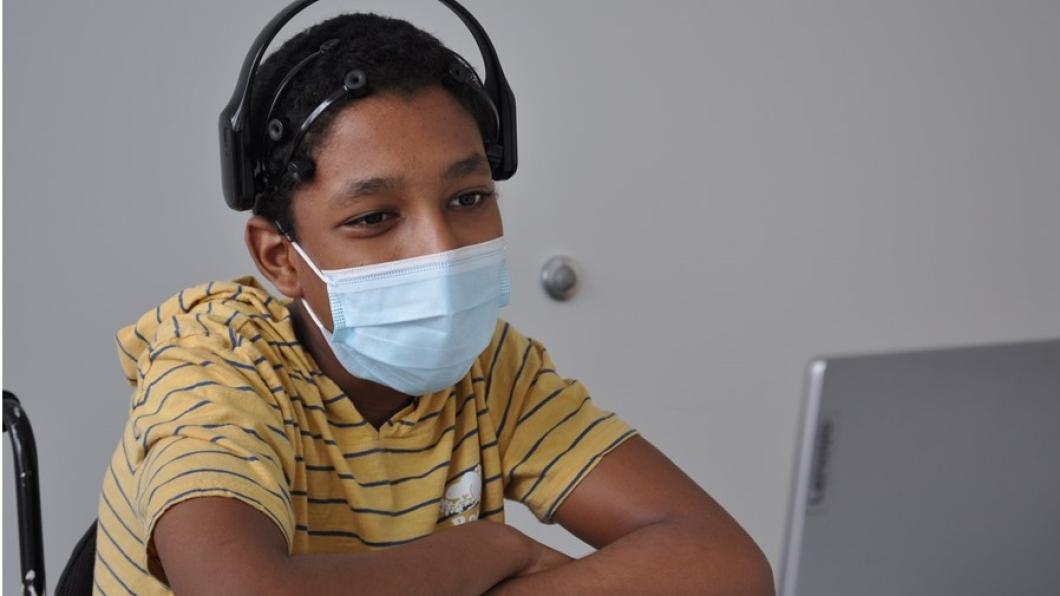
Imagine being able to control your environment, such as turning on a light switch, with only your mind?
It may sound like the stuff of science fiction—but brain computer interface technology being developed at Holland Bloorview is helping kids with severe disabilities harness the power of their thoughts to control the environment around them.
A Brain Computer Interface (BCI) clinic, launched at the hospital in 2019, is helping to open up a world full of greater autonomy and independence for children and youth with conditions that can significantly limit the control of movements. This includes children with cerebral palsy, acquired brain injuries, stroke, muscular dystrophy and spinal cord injury, among others. The clinic focuses on BCI skill development and recreation activities, empowering participants to do things including painting, playing music and video games and driving a race car around a track—using only the power of their mind.
For the past 20 years, Holland Bloorview’s PRISM Lab has been leading the development in assistive technologies, with an increasing focus on brain computer interfaces. The PRISM Lab is also a leader in pediatric BCI research – research that is increasingly being used to inform the work that the BCI clinic is doing and there are only a handful of researchers in this area.
How it works
Brain computer interfaces (BCIs) are computer systems that take brain signals and translate them into commands. Sensors are positioned on a user’s head and can detect their brain activity in the form electrical signals that are analyzed by a computer. Users control BCIs by thinking about specific things—imagining their favourite place, singing a song in their mind or imagining movement (e.g. closing and opening a fist). With practice, the BCI learns the specific patterns of the user’s brain to perform a task, such as controlling music or playing a game. For example, participants can turn on their favourite YouTube video just by thinking.
“Holland Bloorview serves a population of children who are completely dependent on caregivers to speak and act for them. BCI allows these children to experience a greater degree of autonomy,’” says Dr. Tom Chau, Vice President of Research at Holland Bloorview and Director of the Bloorview Research Institute.
A huge “breakthrough”
Many parents and children who visit Holland Bloorview’s BCI clinic describe the huge “breakthrough” they experience the first time they use BCI technology. “The families who come to the clinic know that their child has thoughts. Many of these children are non-verbal and don’t have a reliable communication system. For the first few ‘activations’ everyone is typically holding their breath,” says Susannah Van program coordinator for the Brain Computer Interface Program. “When they see the technology working for the first time, they’re generally blown away and just amazed that someone other than them can see their child’s mind working!”
Samah Darwish and Naser Alnaser are parents to Giselle, six, who has global developmental delay due to an extremely rare gene related mutation. They recall the first time their daughter, who is non-verbal and experiences challenges with movement, used BCI technology at Holland Bloorview. They describe the technology as a “silver bullet” for children including Giselle and would like to see it grow and evolve even further so that Giselle could use it to communicate independently, control her electric wheelchair on her own or even open the fridge to get a snack.
“Right now Giselle is fully dependent on us when it comes to communication. For example, if she wants to tell us she’s thirsty—or even take a nap—someone else needs to use her communication book or aid with her,” says Alnaser. “We see huge potential with this technology to allow Giselle to function more independently. Both my wife and I work in technology and we’re fairly savvy so we understand the potential and promise of this technology to do amazing things for our daughter.”
What’s next for Brain Computer Interface technology?
Beginning in Fall 2022, communication will be added to the BCI clinical program at Holland Bloorview. This means that participants will be able to do things such as select a pictograms from a communication book and/or aid to communicate their needs and desires to those around them. Mobility—including the ability to drive one’s own wheelchair—is another future application. Recent Holland Bloorview research also suggests that BCIs can detect imagined speech of specific words, which would open potentially unlimited possibilities for kids and youth when it comes to communicating with the world around them.
Partnering for possibility
Holland Bloorview will continue to work with two other hospitals – the Alberta Children’s Hospital and Glenrose Rehabilitation Hospital – as part of a pan-Canadian network in developing transformative BCIs that help unlock a world full of possibility—and hope—for kids and youth with disabilities.
Learn more about Holland Bloorview’s BCI clinic